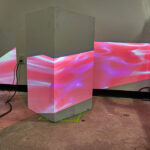 Designing for all clients – young and old, physically healthy and physically challenged – is a hallmark of the Industrial Design curriculum at MIAD.
Designing for all clients – young and old, physically healthy and physically challenged – is a hallmark of the Industrial Design curriculum at MIAD.
That user-centered sensibility lies at the heart of senior Industrial Design student Jeannette Ralyea’s second place win at the International Housewares Association Student Design Competition for her collaborative design, “Visio Guides.”
Ralyea’s win marks the 36th winning MIAD entry in the 19 years of the International Housewares Association Student Design Competition. Her design was selected from 230 entries.
“Visio Guides,” designed with French students Julian Lois and Sylvine Derre, will be on view at the International Home and Housewares Show March 10-13 in Chicago.
 While studying abroad in Nantes, France, at L’Ecole de Design Nantes Atlantique, Ralyea asked to be placed in the French curriculum to have the opportunity to work with French companies, as she was born in Burkina Faso and French is her first language. In one of the courses, Ralyea found herself in a collaborative project with fellow students Lois and Derre.
While studying abroad in Nantes, France, at L’Ecole de Design Nantes Atlantique, Ralyea asked to be placed in the French curriculum to have the opportunity to work with French companies, as she was born in Burkina Faso and French is her first language. In one of the courses, Ralyea found herself in a collaborative project with fellow students Lois and Derre.
She would be missing her Human Factors course while abroad, and in brainstorming for designs, she recommended to Lois and Derre that they learn to design for a specific type of person. Drawing on inspiration from a collaborating company that designs rubber flooring for the visually impaired, she suggested designing products for the visually impaired.
With a set goal in mind, Ralyea, Lois and Derre moved forward. “We found an organization for the visually impaired in Nantes, interviewed some people there and we found one group of five people with whom we could work one-on-one with to design a product to suit their needs,” Ralyea explains.
The chosen clients were not entirely without sight, but still suffered from severe visual impairments. They said it was difficult to use household utilities, such as electrical outlets, light switches and key door locks.
The organization relayed that clients needed to stick their finders into the electrical outlet to determine how to place plugs. Because this is so dangerous, clients would sometimes eat cold soup or go without coffee in the morning.
This input helped the design students narrow their focus for “Visio Guides.” Ralyea says of the design for the electrical outlet, “The whole point of it was to enlarge the surface area so [they] could feel for the center of it, and having reference marks on it to show which direction to plug it in.”
Feeling inspired by the clients, the students did not want to stop at electrical outlets, “We also decided to do light switches because if it’s on a flat surface, it’s really difficult to find. We decided to make a bulbous form so that it really is a large contrast against the flat wall.”
 Bulbous forms help create a contrast against the wall, but the students were interested in having an additional contrasting element in the design. Because the clients could see colors, Ralyea says the group “decided to paint the guides a different color, contrasting to the walls. But, the clients didn’t want us to use ridiculous colors.”
Bulbous forms help create a contrast against the wall, but the students were interested in having an additional contrasting element in the design. Because the clients could see colors, Ralyea says the group “decided to paint the guides a different color, contrasting to the walls. But, the clients didn’t want us to use ridiculous colors.”
The design was a success, and clients remarked, “we would buy this if it was sold in stores.”
When Ralyea returned from her trip abroad, ID Professor Pascal Malassigné saw “Visio Guides” and encouraged her to submit the idea to the design competition.
Ralyea is looking forward to showing her group’s design at the International Home & Housewares Show in March. “I’ll be there showing what I made, handing out samples of my portfolio and trying to get myself a job,” she adds.
Click here for more information on the International Home & Housewares Show.
Click here to read about this accomplishment in Gifts & Tablewares.
Click here for more information on the Industrial Design major, ranked 10th in the nation.
Top and bottom image: “Visio Guides”
Second image: Jeannette Ralyea





